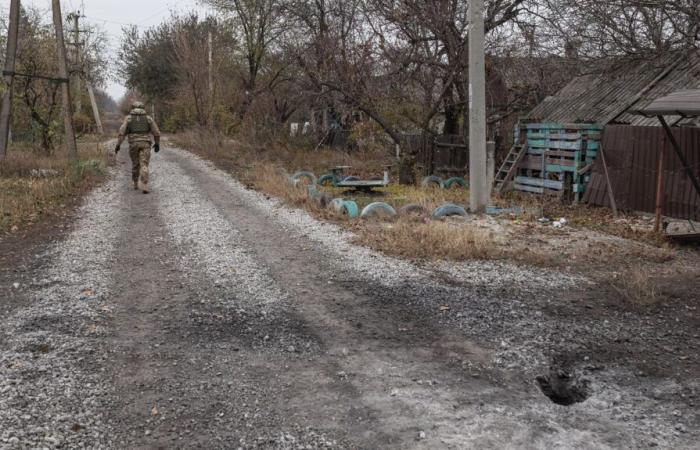These weapons are supposed to help slow the advance of Russian troops in the east of the country, but they also represent a threat to civilian populations. The United States said it would give up mines in June 2022.
After more than a thousand days of war to repel Russia's offensive, US President Joe Biden gave the green light to send antipersonnel mines to Ukraine. The information, revealed by the Washington Postwas confirmed on Wednesday, November 20, by the Secretary of Defense, Lloyd Austin, and the spokesperson for American diplomacy, Matthew Miller.
This military aid is a new demonstration of the United States' efforts to strengthen Ukraine's defensive capabilities, two months before Donald Trump's return to the White House. But it also arouses criticism, due to the danger of these explosives for civilian populations. Franceinfo takes stock of the questions raised by the American announcement.
1 What type of antipersonnel mines will the United States deliver to Ukraine?
According to US Defense Secretary Lloyd Austin, antipersonnel mines supplied by the United States to Ukraine are “non-persistent”that is to say they are equipped with a self-destruction or self-deactivation mechanism intended to reduce their lifespan.
To function, these explosive devices are equipped with an electric battery. When this is discharged, the mines become inactive or self-destruct. “The battery will run out (…) a maximum of two weeks after their deployment (…) so that they will no longer represent a threat to the civilian population at the end of the conflict”detailed State Department spokesperson Matthew Miller.
The American official assured that these were mines “very different” of those deployed by Russia: “The landmines that the Russians have deployed in Ukraine, numbering around two million, will remain a threat for decades.”
2 Why is Joe Biden allowing Ukraine to use mines now?
The sending of these antipersonnel mines is part of a desire by the Joe Biden administration to support Ukraine's war effort a few weeks before the end of its mandate, in January, and the return of Donald Trump at the White House, who questions the continuation of American military aid to kyiv. The United States has just given the green light to the use of long-range missiles against Russian territory. An authorization that Ukrainian President Volodymyr Zelensky has long requested, but which the West has until now refused to grant.
This decision to supply mines is also motivated by the evolving situation in eastern Ukraine, where the advance of Russian troops is accelerating. These explosives should help kyiv respond to a tactical change by Russian troops, according to Lloyd Austin: “The mechanized forces are no longer in the lead. They are advancing on foot in order to approach and do things to open the way for the mechanized forces.”explained the American Secretary of Defense on Wednesday. Ukrainians “need things that can help slow down this effort on the part of the Russians.”
3 Would Ukraine be breaking international law by using these antipersonnel mines?
Sending these explosives to kyiv faces a major obstacle: the Ottawa Convention. Also known as the International Anti-Personnel Mine Ban Treaty, this text was adopted in 1997 and aims to prohibit the use, production, stockpiling and transfer ofes explosive weapons designed to be activated by the presence or proximity of a person. According to the UN, 164 of its member states are bound by this convention, including Ukraine (but not Russia). However, since the start of the war, kyiv has been demanding these explosives, already used by the Russian army, reports the Washington Post.
If the United States has never ratified this text, the Biden administration was committed, in official note of June 2022to align with “the main requirements of the Ottawa Convention” and limit its use of antipersonnel mines. The United States had notably announced that it would stop developing and exporting these explosives. They had also assured their intention to destroy all their existing stocks, with the exception of those intended for South Korea.
Two months earlier, in a previous communiquéthe United States had claimed to deliver to Ukraine M18A1 Claymore type mines. This decision, prior to the commitment to no longer export these weapons, was justified by presenting these mines as “configured to be consistent with the principles of the Ottawa Convention“. Claymore mines have the particularity of being triggered on command by an operator, and not automatically by the presence of a person nearby, explains the American magazine Forbes.
4 What were the reactions to this authorization?
Many voices have been raised against sending antipersonnel mines to Ukraine. The International Campaign to Ban Landmines (ICBL), an organization awarded the Nobel Peace Prize in 1997, has ruled “disastrous” Washington's announcement. “This decision is unacceptable and represents a serious setback in the global fight against mines“said its director, Tamar Gabelnick.
The NGO Amnesty International denounced a “reckless decision and a deeply disappointing setback for a president who admitted that landmines put more civilians at greater risk.” “This is a shocking and devastating development“added Mary Wareham, deputy director of the crisis, conflict and arms division of Human Rights Watchwarning of the complexity of mine clearance efforts.
Ukraine has become the most mined country in the world, with more than “23% of its land at risk of contamination from landmines and unexploded ordnance“, affirmed the United Nations in October. In 2023, the World Bank already estimated the cost of the mine clearance process at $37.4 billion.






